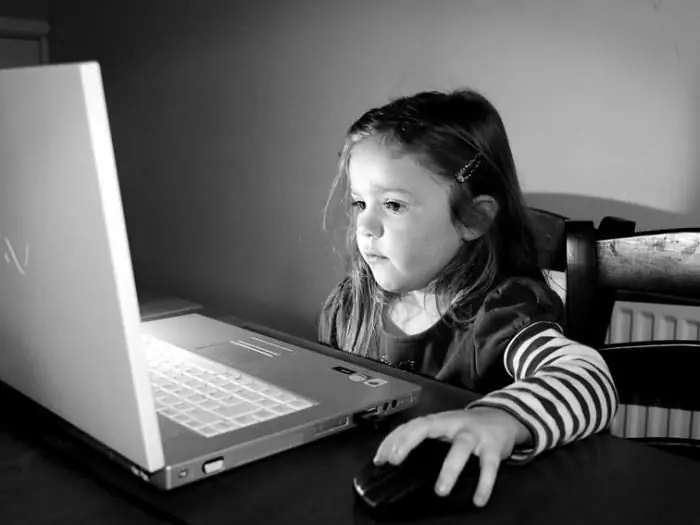2026 Author: Priscilla Miln | [email protected]. Last modified: 2025-01-22 17:55:19
Self-assessment of the child's own personality is a very important aspect when he has behavioral or psychological problems. Therefore, there are many methods aimed at identifying them.
Purpose of application

In fact, there are quite a lot of methods for assessing the child himself. To date, "Tree", "What am I", "Ladder", "Questionnaire" are often used. It is very important that the child understands and correctly assesses himself: you need to correctly form an idea of \u200b\u200bhimself and others. The "Ladder" technique is the most popular, because it is clear and understandable. And it is easy for the interviewer to explain to the children what is required of them. "Ladder" is equally relevant for a wide range of ages.
Description and procedure for the "Ladder" technique
To assess a selected group of children (schoolchildren, especially preschoolers), it is recommended to prepare sheets with a ladder of 7 steps for each child. This material will be useful in the process of an individual conversation.

The rules are explained to the children with a demonstration: children stand on the ladder according to a certain rule:
- on the middle step (4th from the bottom) - neither bad nor good guys;
- a step up (5th from the bottom) - good kids;
- even higher (6th) - very good;
- on the top (on the 7th) - the best.
And in the opposite direction: on the step below the middle (3rd) - there are bad children, even lower (on the 2nd) - very bad, and on the bottom step (1st) - the worst children.
After explaining the mechanism, a conversation is held with the children from the focus group. The main question of self-esteem sounds like this: "Where will you put yourself, on what step?".
Thus, a variety of questions allow a broader characterization of the child's self-perception.
Instead of "good", any word that characterizes a person can be used: smart, strong, brave, honest, stupid, cowardly, angry, lazy, etc.
In addition to self-esteem, you can ask: "What would you like to be? Where will your parents put you? Where will teachers put you", etc.
Interpretation of results
The most important point of this study is the child's decision to place himself on a certain rung. It is considered normal when the baby puts himself on the upper steps (optimally "very good", less often - with thought "the best"). If the lower steps are chosen (the lower, the worse), then this indicates an inadequate perception of oneself, as well as a bad attitude towardsself-doubt.
This deviation can lead to neurosis and depression at such a young age. The reasons that can become prerequisites for the formation of this negative result, as a rule, are associated with education, when authoritarianism, severity, coldness or detachment prevail. In such families, in addition to the will of the parents, it seems that the child is valued only for good behavior. In addition, children cannot always behave well, and every conflict situation leads to self-doubt, in the love of parents for themselves.

A similar situation occurs in families where parents spend little time with their children: neglecting communication with the child leads to similar results.
Problem areas in the family are easily determined by questions about where the child will be placed by parents, teachers or caregivers. For a comfortable perception of oneself, reinforced by a sense of security and care, it is important that one of the close relatives put the child on the top step. Ideally, if this is mom.
Methodology and assessment for different age groups
Depending on the age of the focus group, there are slight variations in how the test is administered. As a rule, this concerns explanation and conduct, the "Ladder" method for schoolchildren can be expanded and supplemented, and for kindergarten groups it can become more visual.
This is not an absolute rule, because test psychologists tailor the questions to suit them.
Method"Ladder" for preschoolers implies a preliminary thorough explanation. For greater clarity, kids can take the doll and put it instead of themselves in the chosen place.
The "Ladder" method for younger students does not imply the presence of additional toys. On the proposed forms, you can draw a figure meaning a child, i.e. yourself.
Subtleties of conducting
Depending on the children studied, the list of characteristics may be expanded or shortened.
When talking with a child, you should pay attention to his reaction: how quickly he gives an answer, whether he makes arguments or hesitates. Explanations about the placement must be present. If they are not there, clarifying questions are asked: "Why this place?", "Are you always here?"
Based on the results, you can tell what type of self-esteem a child has:
1) Inadequately high/low self-esteem.
Inflated: the baby without analysis puts himself on the top rung. To additional questions, he explains that his mother appreciates him and so "said".
Underestimated: the baby indicates the lower steps, which indicates a developmental deviation.
2) Adequate self-esteem is considered when a child considers himself to be "very good" children or with hesitation and argumentation to "the best".
3) In the case when the child puts himself on the middle level, this may indicate that he did not understand the task, or he is not sure of the correct answer and prefers not to take risks by answering "noknow" questions.

If we talk about the distribution of results by age groups, then inflated self-esteem is typical for preschoolers, but younger students are more realistic about themselves. And what is typical for both groups: in familiar situations, children assess themselves adequately, but in unfamiliar situations, they tend to overestimate their abilities.
Recommended:
At what age to get married: legal marriageable age, statistics, traditions of different countries, willingness to be a wife and marry

The legislation of each country determines the minimum marriageable age before which you cannot get married or get married. In different states, the age bar is set based on cultural and historical traditions. And even in Russia, it varies depending on the specific region
Kindergarten Matinees: Scripting Tips for Different Groups

Matinees in preschool institutions are held regularly. They can be tied to generally accepted holidays (New Year, Mother's Day), as well as to other significant events (the onset of autumn, the end of kindergarten). Kids love holidays very much, sincerely rejoice at them. It is important to live up to their expectations. Not the last role is played by a well-written script for a matinee in kindergarten
What makes a family different from other small groups. Family as a small group

Everyone knows what is meant by the word "family". Speaking in terms, this is the basic, main unit of society. But what else distinguishes the family from other small groups? There are a lot of signs. But the main ones should be listed and briefly told about them
Affectionate words for a man: different for different

Despite their masculinity and bravado, men also love affectionate words. And this is wonderful: it means that in their souls they are as gentle and humane as we women are. It’s just that you need to choose affectionate words for a man with great care
The method of education is the way of influencing a person's life. The role of the method of education in the formation of personality

It is psychology that can explain what education is. The method of education is a certain list of rules, principles and concepts that can form a personality out of a person and give that baggage of knowledge that will help him throughout his life path

